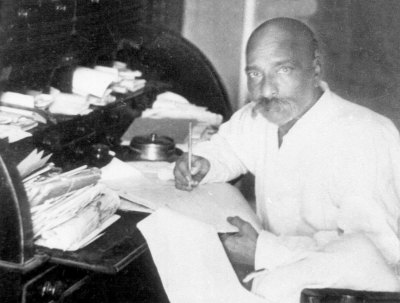By Quaid NajmiPune, Jan.Jan 4 : Dreaded for its lionish roar once, “Kesari”, the newspaper founded by the legendary Lokmanya Bal Gangadhar Tilak completed 140 years on Monday after changing several ‘avatars’ in its long media journey.
Starting from a humble Marathi tabloid on Jan.4, 1881, it transformed into a biweekly, triweekly, daily and finally an e-paper, continuing to serve its dedicated readership in Marathi.
In fact, it had a two-day older English sibling ‘Mahratta’, a periodical which also celebrated it 140 years on Saturday after experiencing many depths and peaks, and both precede the founding of the Indian National Congress in 1885.
“Kesari” (meaning Lion in Sanskrit), was started in 1881 as a tabloid by a group of like-minded young friends comprising Tilak, then 25, Gopal G.Agarkar who was its first Editor, Mahadev B.Namjoshi, Vaman S.Apte and Ganesh K.Garde.Today, it is the only vernacular language newspaper being published by a Trust without break for the past 140 years,” current Editor Dr.Deepak J.Tilak told IANS.
Sitting on an imposing desk with a huge portrait of his great-grandfather behind him, he said that the journey of “Kesari” merits a special mention in Indian media history as it was not merely the account of a Marathi newspaper but a historical record of the country’s journey in the past 140 years.
“The ‘Kesari’ has witnessed a period of not less than three centuries, pursued the aim of ‘Swaraj’ in the pre-Independence period, then ‘Su-raj’ in the post-Independence era.Throughout, it has impacted the people of Maharashtra in its own way, across all spheres of the country’s social-academic-political-economic life,” Dr.Tilak said with pride.
Lokmanya Tilak used it as a weapon to awaken the masses during the freedom struggle, propounded Swadeshi along with Swaraj, and united the common folk with mass celebration of festivals like Ganeshotsav in the state.
Besides, Marathi, “Kesari” was briefly published in Hindi and Gujarati, along with “Mahratta” in English to cater to the widest possible audiences from the commoners to the classes, and dared the might of the British rulers despite imprisonment for its owners or editors.
Lokmanya Tilak himself attracted grave sedition charges (1897 and 1908) for his bold writings, and awarded a six-year term at Mandalay Jail in modern-day Myanmar (formerly, Burma), where he penned the treatise, “Gita Rahasya”.
Some of Lokmanya Tilak’s famous and historic sayings still seem to echo in the small museum at Tilakwada – the office of the “Kesari” group, which also continues to serve as the residence of his descendents.
Among them is the resounding – “Swaraj is my birthright and I shall have it” (1906), and during his sedition trial – “Inspite of the verdict of the jury, I maintain, I am innocent.
There are higher powers that rule the destiny of things and it may be the will of Providence that the course I represent is to prosper more by my sufferings than my remaining free”.
Those fiery thoughts and speeches continued to scream aloud from the pages and columns of “Kesari” all these years, as it metamorphosed from a tabloid to a biweekly in Aug.1929, a tri-weekly in Jan.1951 and finally a broadsheet in Oct.1962, bringing a digital edition for television audiences besides donning the e-avatar in 2019.
Later, Lokmanya’s grandson and then “Kesari” Editor Jayantrao Shridhar Tilak, plunged into the Goa Liberation Movement and other agitations, suffered jail terms, served as a parliamentarian, legislator, and was elected the Chairman of Maharashtra Legislative Council.
As the newspaper continued its nation-building task for 14 long decades, Dr.Deepak J.Tilak also spent over 16 years to rebuild the historic Tilakwada in pieces depending on availability of funds, to a three-buildings, five-storied structure in Narayan Peth area of the state’s academic, cultural and IT capital (Pune).
Given the tough days of its existence, the rents earned from the premises helps sustain the newspaper and its dedicated staff amid stiff competition from other major Marathi publications in the state.
Over the years, the group established coveted awards like the “Lokmanya Tilak Award” (from 1983) and “Lokmanya Tilak National Award for Excellence in Journalism” (from 2009), awarded to prominent personalities.
(Quaid Najmi can be contacted at: q.najmi@ians







